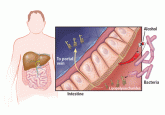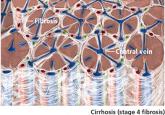Article

Alcoholic hepatitis: Challenges in diagnosis and management
Severe alcoholic hepatitis is a devastating acute condition that requires early recognition and specialized tertiary medical care.
From Cleveland Clinic Journal of Medicine 2015 Jul;82(7):404-405. </br>Ascites is the major predisposing factor, since it causes muscle wasting and increases intra-abdominal pressure.
PIETER MARTENS, MD
Department of Internal Medicine, University Hospital Gasthuisberg, Catholic University Leuven, Vlaams Brabant, Belgium
WIM LALEMAN, MD, PhD
Department of Liver and Biliopancreatic Disorders, University Hospital Gasthuisberg, Catholic University Leuven, Vlaams Brabant, Belgium
ADDRESS: Pieter Jan Paul Martens, MD, Department of Internal Medicine, University Hospital Gasthuisberg, Catholic University Leuven, Herestraat 49, Leuven, Vlaams Brabant 3000, Belgium; e-mail: pieter.1.martens@uzleuven.be

A 62-YEAR-OLD MAN was admitted to the intensive care unit with esophageal variceal bleeding. He had a long history of alcohol abuse with secondary cirrhosis, with a Child-Pugh score of 11 on a scale of 15 (class C—the most severe) at presentation. He also had a history of uncomplicated umbilical hernia, 6 cm in diameter without overlying trophic skin alterations.
Treatment with somatostatin, endoscopic band ligation, and prophylactic antibiotics was initiated for the variceal bleeding. The next day, he was transferred to the hepatology floor. His condition stabilized during the next week, but then he abruptly became diaphoretic and less talkative. Physical examination revealed a painful and irreducible umbilical hernia (Figure 1). He was rushed for umbilical hernia repair with resection of a necrotic segment of small bowel. His recovery after surgery was uneventful, and he was eventually discharged.
UMBILICAL HERNIA AND CIRRHOSIS
Umbilical hernia is common in cirrhotic patients suffering from ascites, with a prevalence up to 20%, which is 10 times higher than in the general population.1 Ascites is the major predisposing factor since it causes muscle wasting and increases intra-abdominal pressure.
A unique feature of cirrhosis is low physiologic reserve, which increases the risk of death from complications of umbilical hernia and makes the patient more vulnerable to perioperative complications during repair. Because of the high operative risk, umbilical hernia repair has traditionally been reserved for the most complicated cases, such as strangulation of the bowel or rupture of the skin with leakage of ascitic fluid.2,3 Many patients are thus managed conservatively, with watchful waiting.
However, the natural course of umbilical hernia tends toward complications (eg, bowel incarceration, rupture of the overlying skin), which necessitate urgent repair.4 The risk of death with hernia repair in this urgent setting is seven times higher than for elective hernia repair in cirrhotic patients.5 More recent data indicate that elective repair in patients with well-compensated cirrhosis carries complication and mortality rates similar to those in noncirrhotic patients.5–8 Therefore, patients who should undergo umbilical hernia repair are not only those with complicated umbilical hernia (strangulation or ascites leak), but also those with well-compensated cirrhosis at risk of complications.
Factors that pose a particularly high risk of complications of repair are large hernia (> 5 cm), hernia associated with pain, intermittent incarceration, and trophic alterations of the overlying skin.1 In these patients, elective repair should be considered if hepatic function is preserved, if ascites is well managed (sodium restriction, diuretics, and sometimes even preoperative transjugular intrahepatic portosystemic shunt placement), and if the patient is not expected to undergo liver transplantation in the near future. If liver transplantation is anticipated in the short term, umbilical hernia can be managed concomitantly. Management of ascites after umbilical hernia repair is essential for prevention of recurrence.

Severe alcoholic hepatitis is a devastating acute condition that requires early recognition and specialized tertiary medical care.

The need for liver biopsy is diminishing, thanks to accurate blood tests and imaging studies.
